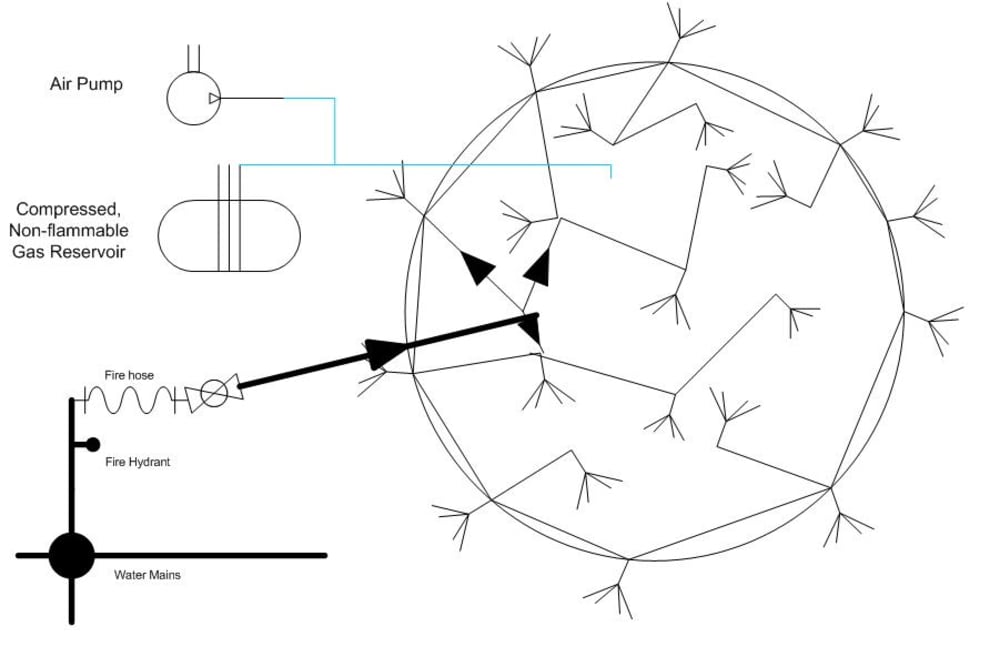BOTTOM LINE UP FRONT
When a fire is enclosed, its heat is reflected back onto the fuel, causing acceleration. The Fireball is a giant beachball-like structure studded with sprinkler heads. Its spray is omnidirectional, in contrast to hose spray through a window.
DELIVERY
Delivery of a large Fireball is via a boom extended in the same way as an extension ladder. A smaller Fireball can be man-packed to its target location.
FUNCTION
Placed within a burning structure, it is inflated internally with air or non-flammable gas. An air pump or gas cylinder can be used.
Either during or after inflation, its external sprinklers are pressurized through a fire hose. The cool inflating or inflated surface absorbs rather than reflects heat, while spraying water on the flames. As it inflates, it conforms to the shape of its containing room or environment.
SECONDARY PURPOSES
FIRE BREAK
Inflating the Fireball in a room near active flame removes that room's supply of oxygen to the fire. In the absence of fire it forms a boundary that, while dry, provides support to overhead structures. If required in this role, water can be supplied and the Fireball will wet and cool the volume it occupies.
SAFETY BARRIER
In a rescue situation, the Fireball becomes a barrier to flames allowing firefighters to get very near to a fire with reduced risk. The Fireball can give victims the few precious minutes needed to escape or be rescued.
ENGINEERING
None of the concepts here are difficult, notionally. Some hydraulic engineering would be required to develop a system with the correct flow dynamics in a flexible fabric structure such that pressure at all sprinkler heads receive nearly equal water flow.
Piping, fabric, fittings and lining materials as well as the gas delivery portion would need to be selected for fire resistance and, possibly, re-utilization.
DRAWBACKS/RISKS
1. The Fireball could be too heavy to be man-packed.
* A boom delivery system mitigates this risk.
2. The Fireball might smother or crush people, particularly infants and the inform.
* Red DEFLATION flags could be spaced over the Fireball
* As digital camera prices plummet, incorporate wireless cameras into the design
3. The Fireball may not be re-usable.
* Down-select materials based upon function and re-use
4. The Fireball may be very expensive.
* Cost-benefit analysis should be undertaken
5. The Fireball is dependent upon both gas inflation AND water supplies being present simultaneously
* Carry inert gas inflation canisters
* Make compatible with Scott Air Pack style gas canisters
6. Fireball removal would likely be very time-consuming.
* Include both a water-removal pump and a vacuum deflation system
PRODUCTION
A Fireball should be produced about as easily as a batch of fire hoses.
Other Fireball shapes could be fabricated.
Hard-mounted Fireballs could used in buildings.
Small, self-inflating, waterless 'Dry Fireballs' could be deployed to create barriers and isolate heat from fuel. Cluster packs of Dry Fireballs could be used to support failing structures and slow fire's spread.
Like this entry?
-
About the Entrant
- Name:Shawn Hendricks
- Type of entry:individual
- Hardware used for this entry:NoneSoftware used for this entry:Microsoft Visio
- Patent status:none

